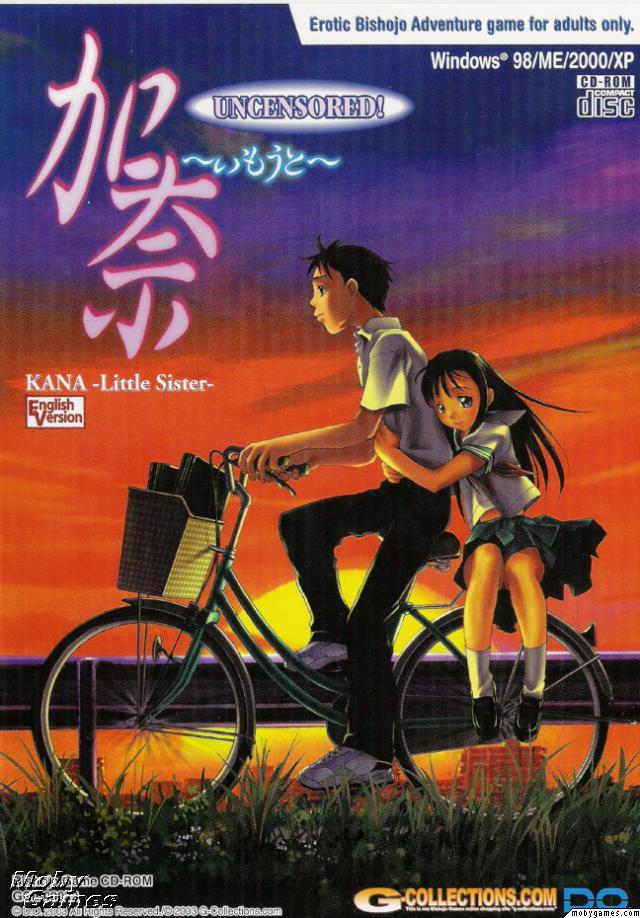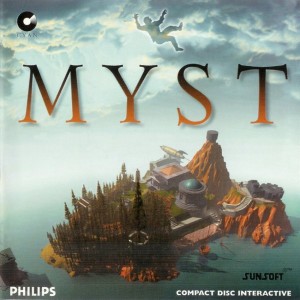 They talk about being a big fish in a small pond. Kana Little Sister is a whale imprisoned in a raindrop. In 1999, the hentai/eroge industry (“Do You Like Horny Bunnies”, “Battle Raper”, etc) released this very sad and emotional game, which is unlike any other h-title I’ve played or heard about. It has sexual content, but it could be deleted off the disc without affecting the experience. Kana exists to exposit one of gaming’s most tragic love stories, and tissues will now absorb other bodily fluids.
They talk about being a big fish in a small pond. Kana Little Sister is a whale imprisoned in a raindrop. In 1999, the hentai/eroge industry (“Do You Like Horny Bunnies”, “Battle Raper”, etc) released this very sad and emotional game, which is unlike any other h-title I’ve played or heard about. It has sexual content, but it could be deleted off the disc without affecting the experience. Kana exists to exposit one of gaming’s most tragic love stories, and tissues will now absorb other bodily fluids.
The game is about the coming of age of siblings Taka and Kana. Kana suffers from chronic renal failure. The expectation is that she will die at some point. Taka is initially resentful of Kana, but their relationship soon changes into friendship and then sexual intimacy. The game explores a lot of deep themes, like forbidden love and acceptance of death. I enjoyed the story, as well as Taka and Kana’s relationship, which is given beautiful frisson by the fact that it will not last.
The word “game” keeps coming up but Kana deserves it no more than the word “hentai”. This is the least interactive “game” I’ve ever seen, you just click dialogue options and get railroaded to one of six endings. Even though you play it less than you “play” an ink and paper RL Stine “Give Yourself Goosebumps” book, the minimalistic gameplay actually works to keep your attention on the story.
The art is nice. The music is repetitive and distracting. There’s no voice acting. The whole thing takes about five hours to complete. Kana’s an embodiment of function over form. It has little to offer if you want production values, it relies on content to woo the player. But honestly, I still have reservations about the whole “player” thing. Know what you’re getting into with this one: it’s not a game, it’s a vaguely interactive novel. And that might be a problem. Kana has one of the most emotionally affecting stories ever seen in a videogame, but if you judge “Kana” as a book…well, there’s a bit more competition there, no?
Kana is not great literature. It draws an emotional reaction in the same way a soap opera does. Sometimes the story’s twists and turns feel organic and natural. Sometimes they come across as phony and manipulative. And that’s a shame. Kana is too great to be a hentai game…but not good enough to cut it as a book. It’s stuck somewhere between worlds. Someone looking for porn won’t find it here, and it probably won’t win over highbrow lit fans. I’m reminded of a chrysalis. One one end a caterpillar, on the other end a butterfly…and in between there’s this really odd thing that doesn’t seem to belong.
Kana Little Sister is an interesting game, and certainly worth checking out. It will probably draw a “that’s it?” reaction from many players. It’s short, it’s crude, and it’s barely interactive. But when the story gets going, you will forget about all of that. In the tale of Taka and Kana there’s something very rare in a game storyline: inspiration.

Myst was advertised for years as a computer game for people who don’t like computer games.
The graphics were and still are beautiful. I can think of no better use for your i386 processor and Mach 64 video card. Someone once said that Doom was the first game that could impress a non-geek with its graphics, and while that may be true, Doom was a game of small rooms and corridors. Myst’s pre-rendered environments look even better, and it came on a CD-ROM when that alone was a selling point.
But Myst cannot be played, only be experienced. It’s an interactive travel brochure. You click and look at pictures and get bored and stop. The game’s world is beautiful, but the sterility and lack of motion soon feels creepy, like you’re trapped between two frames of a movie.
For a lot of people, Myst (and The 7th Guest, which had a Myst-like ambiance) was their first experience playing an adventure game, which is like someone’s first experience with cinema being a 5 hour foreign language art film. Myst probably helped kill adventure gaming: the public’s perception of the genre swiftly became “games where you don’t have any fun.”
Too bad. The Monkey Island and Leisure Suit Larry titles contain funny writing and interesting puzzles. Infocom’s A Mind Forever Voyaging had a compelling dystopian story, and that game didn’t even have graphics. Myst just has the gestalt of moving around in a beautiful, eerie, slightly interactive world. Too bad you can’t play hype or this would be the most fun game ever made.
 This is Monolith’s innovative but obscure mecha-themed first person shooter from 1998. It’s full of cool stuff, but it isn’t a classic. This is the type of game that comes out, impresses some people, and then just goes away.
This is Monolith’s innovative but obscure mecha-themed first person shooter from 1998. It’s full of cool stuff, but it isn’t a classic. This is the type of game that comes out, impresses some people, and then just goes away.
I’ve never seen a game so eager to impress. It cavorts like a puppy. It has a strong and stylish anime theme, an complex and detailed story (by the standards of the day, anyway), lots of features, and an early test drive of the flashy Lithtech engine. Shogo does look the part. But soon you realise that the game’s content is not able to match its presentation.
Everything seems…rushed. Unready. Unfinished. There’s definitely a meal here, but it bleeds and squeals when I cut it. The game is a two-part experience. There’s on-foot FPS missions, and mecha missions – which are the same but from the perspective of 50 meters in the air, with you shouldering past buildings like Godzilla, and people running around your feet like little ants. Both parts of the game feel half-completed, as if the designers were trying to do too much and then eventually gave up.
Pour water into any part of the game and it leaks.
Weapons? The game basically gives you the entire arsenal from the start of the game. Unsatisfying. Where’s the thrill of progressing through the game and finding more and more powerful weapons? Imagine Doom if it gave you the plasma gun on the second level and the BFG 9000 on the third.
AI? Hopeless. In mecha mode your robot enemies get stuck going around corners, kill themselves with explosive weapons, etc. On the ground, you progress through hallways, fighting static groups of enemies that stand still even while you blast their friends from just around the corner. There are friendly soldiers that help you from time to time. You can kill them without consequence.
Level design? Not interesting, there’s a level ripped off from Quake where you ride around on wind turbines etc but otherwise it’s your usual series of techbases and “gritty” urban locales where you must flip switches and find keys. I think there was one level where you have to interrupt your quest to save the world to rescue a lady’s pet cat.
Giant robots? Here’s where the game really keels over and fucks itself. This game never makes it feel like you’re riding a hundred ton battle mecha. You can stop on a dime, make huge, floaty jumps, execute impossible mid-air pirouettes – the physics are all wrong, and it destroys the immersion and atmosphere of the game.
Story? Fairly expansive and detailed for an FPS, but it lacks colour and human interest. Shogo’s story feels like Metal Gear Solid’s story retold by an autist or a sociopath. Characters and their motivations are described in plain, anodyne terms (such and such is the brother of so and so, who is the girlfriend of who and who). The anime theme seemed cool in 1998 but these days you’d be better off playing anything from the later Touhou games to Viewtiful Joe. In general, the largeness and outlandishness of anime is missing. Monolith has copied the words but they don’t seem to hear the music.
It didn’t help that Shogo was released at just the wrong time. Half Life caused better games than Shogo to be forgotten.
 They talk about being a big fish in a small pond. Kana Little Sister is a whale imprisoned in a raindrop. In 1999, the hentai/eroge industry (“Do You Like Horny Bunnies”, “Battle Raper”, etc) released this very sad and emotional game, which is unlike any other h-title I’ve played or heard about. It has sexual content, but it could be deleted off the disc without affecting the experience. Kana exists to exposit one of gaming’s most tragic love stories, and tissues will now absorb other bodily fluids.
They talk about being a big fish in a small pond. Kana Little Sister is a whale imprisoned in a raindrop. In 1999, the hentai/eroge industry (“Do You Like Horny Bunnies”, “Battle Raper”, etc) released this very sad and emotional game, which is unlike any other h-title I’ve played or heard about. It has sexual content, but it could be deleted off the disc without affecting the experience. Kana exists to exposit one of gaming’s most tragic love stories, and tissues will now absorb other bodily fluids.

